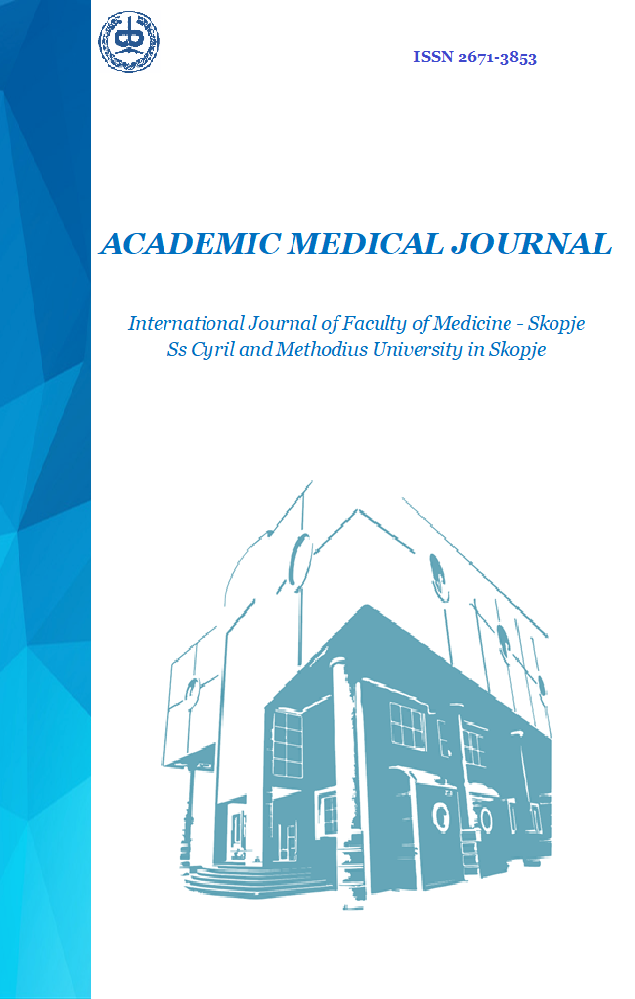IMPACT OF CEREBRAL PERFUSION STRATEGIES ON NEUROLOGICAL OUTCOMES IN AORTIC ARCH REPAIR USING THE FROZEN ELEPHANT TRUNK TECHNIQUE
Keywords:
Aortic arch surgery, frozen elephant trunk, cerebral protection, spinal chord injuryAbstract
This study aimed to evaluate the impact of various cerebral perfusion strategies on neurological outcomes, comparing our results on trilateral antegrade cerebral perfusion (tACP) to reported rates from latest literature analysis on bilateral antegrade cerebral perfusion (bACP) and unilateral antegrade cerebral perfusion (uACP).
Methods: A retrospective analysis was performed on 15 patients who underwent surgical intervention at the University Clinic for Cardiac Surgery in Skopje between 2018 and 2023. All patients included had elective chronic aortic dissections. Preoperative evaluation encompassed a detailed medical history, physical examination, diagnostic imaging, and risk stratification using the EuroSCORE II model. Standardized surgical techniques, including trilateral cerebral perfusion, were employed intraoperatively. The primary endpoint was the incidence of major neurological complications, including stroke and SCI, while the secondary endpoint was all-cause mortality.
Results: Major neurological events, including stroke and transient ischemic attack (TIA), were observed in 6.7% of patients, with SCI occurring in a single case (6.7%). These rates are notably lower than previously reported figures of 5-15% for procedural strokes following complex aortic arch repairs employing uACP or bACP. All-cause mortality in our cohort was 20%, compared to the 31% reported in the literature for patients undergoing open aortic arch repair.
Conclusion: In patients undergoing total aortic arch repair with the FET technique, tACP appears to be a viable strategy for cerebral and spinal cord protection. The complication rates observed in our cohort are favorable and support further investigation with larger patient populations to validate these findings.
References
Isselbacher EM, Preventza O, Hamilton Black J 3rd, Augoustides JG, Beck AW, Bolen MA, et al. 2022 ACC/AHA Guideline for the Diagnosis and Management of Aortic Disease: A Report of the American Heart Association/American College of Cardiology Joint Committee on Clinical Practice Guidelines. Circulation 2022; 146(24): e334-e482. doi: 10.1161/CIR.0000000000001106.
Czerny M, Grabenwöger M, Berger T, Aboyans V, Della Corte A, Chen EP, et al. EACTS/STS Guidelines for Diagnosing and Treating Acute and Chronic Syndromes of the Aortic Organ. Ann Thorac Surg 2024; 118(1): 5-115. doi: 10.1016/j.athoracsur.2024.01.021.
Shrestha M, Bachet J, Bavaria J, Carrel TP, De Paulis R, Di Bartolomeo R, et al. Current status and recommendations for use of the frozen elephant trunk technique: a position paper by the Vascular Domain of EACTS. Eur J Cardiothorac Surg 2015; 47(5): 759-769. doi: 10.1093/ejcts/ezv085.
Kayali F, Chikhal R, Agbobu T, Jubouri M, Patel R, Chen EP, et al. Evidence-based frozen elephant trunk practice: a narrative review. Cardiovasc Diagn Ther 2023; 13(6): 1104-1117. doi: 10.21037/cdt-23-300.
Furutachi A, Takamatsu M, Nogami E, Hamada K, Yunoki J, Itoh M, et al. Early and mid-term outcomes of total arch replacement with the frozen elephant trunk technique for type A acute aortic dissection. Interact Cardiovasc Thorac Surg 2019; 29(5): 753-760. doi: 10.1093/icvts/ivz154.
Acharya M, Sherzad H, Bashir M, Mariscalco G. The frozen elephant trunk procedure: indications, outcomes and future directions. Cardiovasc Diagn Ther 2022; 12(5): 708-721. doi: 10.21037/cdt-22-330.
Salem R, Van Linden A, Hlavicka J, Karimian-Tabrizi A, Ischewski I, Walther T, et al. Trilateral versus Bilateral Antegrade Cerebral Perfusion in Frozen Elephant Trunk: A Propensity Score Analysis. Thorac Cardiovasc Surg 2025; 73(1): 25-32. doi: 10.1055/a-2228-7189.
Angeloni E, Melina G, Refice SK, Roscitano A, Capuano F, Comito C, et al. Unilateral Versus Bilateral Antegrade Cerebral Protection During Aortic Surgery: An Updated Meta-Analysis. Ann Thorac Surg 2015; 99(6): 2024-2031. doi: 10.1016/j.athoracsur.2015.01.070.
Angleitner P, Stelzmueller ME, Mahr S, Kaider A, Laufer G, Ehrlich M. Bilateral or unilateral antegrade cerebral perfusion during surgery for acute type A dissection. J Thorac Cardiovasc Surg 2020; 159(6): 2159-2167.e2. doi: 10.1016/j.jtcvs.2019.06.057.
Tsagakis K, Osswald A, Weymann A, Demircioglu A, Schmack B, Wendt D, et al. The frozen elephant trunk technique: impact of proximalization and the four-sites perfusion technique. Eur J Cardiothorac Surg 2021; 61(1): 195-203. doi: 10.1093/ejcts/ezab295.
Downloads
Published
Issue
Section
License
This work is licensed under CC BY 4.0 





